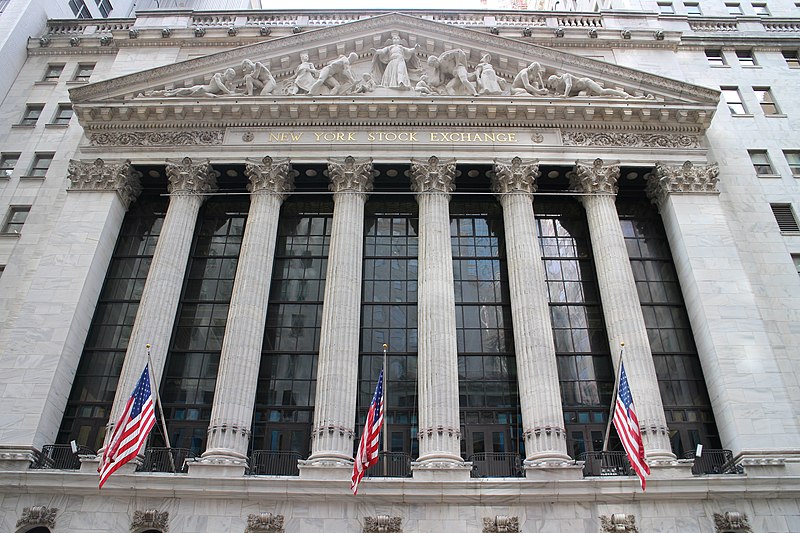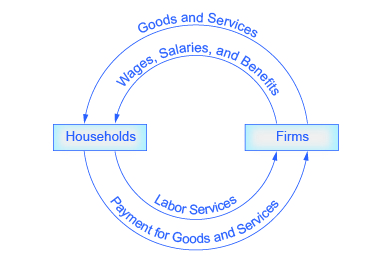1.4 – Basic Features of Capitalism
Learning Objectives
By the end of this section, you will be able to:
- Identify the basic components of a capitalist economy
- Define essential concepts in economics, including market and theory
- Construct a model of the economy in terms of the interaction of households and businesses through market exchange
Economics is not limited to studying only capitalist economies, but odds are the economies you’ll be studying as you work through this text will be principally capitalist in composition. Capitalism is sometimes called the free-market or private-enterprise system. A market is an institution that brings together buyers and sellers of goods or services. These buyers and sellers may be individuals, businesses, governments, or other types of organization.

Market economies are based on private enterprise: the means of production (resources, technologies, and businesses) are acquired through investment, and owned and operated by private individuals or groups of private individuals with a basic goal of earning profits. Governments, then, protect these property rights, help to settle disputes between different parties (for example, two competing businesses), and to varying degrees regulate all sorts of economic activity.
In a capitalist economy, profit is one way to garner an income and, if we’re sticking to just the basics, wages are the other (of course there are plenty of other ways to make money as well). While it’s possible to have a free-market economy in which everyone is a business owner, in actual modern capitalist economies, the private ownership of the means of production is always accompanied by a working class who must earn their living by working for the business owners. And, as you’ll learn in various chapters throughout this text, economists have very different theories about how these different types of income fit together in capitalist economies.
A Simple Model of Capitalism
A theory is a simplified representation of how two or more variables interact with each other. The purpose of a theory is to take a complex, real-world issue and simplify it down to its essentials. If done well, this enables the analyst to understand the issue and any problems around it. A good theory is simple enough to be understood, while complex enough to capture the key features of the object or situation being studied.
Sometimes economists use the term model instead of theory. Strictly speaking, a theory is a more abstract representation, while a model is more applied or empirical representation. Models are used to test theories, but for this course we will use the terms interchangeably.
A very basic model to start with in economics is the circular flow diagram, which is shown in Figure 2. It pictures the economy as consisting of two groups—households and businesses (or ‘firms’)—that interact in two markets: the goods and services market in which firms sell and households buy and the labor market in which households sell labor to businesses.

Of course, in the real world there are many different markets for goods and services and markets for many different types of labor. There are also markets for financial capital and productive equipment, markets in which firms buy from and sell to each other, and there are often quite complex internal processes within firms as well as households. There are, likewise, other organizations–non-profits, civic organizations, trade associations, governments–not depicted.
The circular flow diagram simplifies all this to make the picture easier to grasp, though we could add more details if we wanted to. In the diagram, firms produce goods and services, which they sell to households in return for revenues. This is shown in the outer circle, and represents the two sides of the market for goods and services in which households demand (buy) and firms supply (sell). At the same time, households sell their labor as workers to firms in return for wages, salaries, and benefits. This is shown in the inner circle and represents the two sides of the labor market in which households supply and firms demand.
Economists carry a set of theories in their heads like a carpenter carries around a toolkit. When they see an economic issue or problem, they go through the theories they know to see if they can find one that fits. Then they use the theory to derive insights about the issue or problem. If no theory proves useful to the problem, then a new theory should be constructed based on observations about the issue at hand.
In economics, theories can be expressed as diagrams, graphs, mathematical equations, or simply in words. Both micro- and macroeconomics are explained in terms of theories and models. The most well-known theories are probably those of supply and demand, but you will learn many others throughout this text as well, including some that outright reject the theoretical framework of supply and demand–pluralism, indeed.
Glossary
- circular flow diagram
- a diagram that views the economy as consisting of households and firms interacting in a goods and services market and a labor market
- goods and services market
- a market in which firms are sellers of what they produce and households are buyers
- labor market
- the market in which households sell their labor as workers to business firms or other employers
- market
- interaction between potential buyers and sellers; a combination of demand and supply
- market economy
- an economy where economic decisions are decentralized, resources are owned by private individuals, and businesses supply goods and services based on demand
- model
- see theory
- private enterprise
- system where the means of production (resources and businesses) are owned and operated by private individuals or groups of private individuals
- theory
- a representation of an object or situation that is simplified while including enough of the key features to help us understand the object or situation
interaction between potential buyers and sellers; a combination of demand and supply
system where the means of production (resources and businesses) are owned and operated by private individuals or groups of private individuals
a representation of an object or situation that is simplified while including enough of the key features to help us understand the object or situation
see theory
a diagram that views the economy as consisting of households and firms interacting in a goods and services market and a labor market
a market in which firms are sellers of what they produce and households are buyers
the market in which households sell their labor as workers to business firms or other employers
